Checking a Wagner cast iron skillet for age, defects, and collectability. Before you purchase your first Wagner skillet, it’s a good idea to check the condition to ensure you’ll be happy with the purchase. Carefully inspecting the skillet also helps you avoid disappointment and makes using vintage ironware much more enjoyable.
Inspecting vintage cast iron pans and looking for faults could prevent you from overpaying or help you negotiate a better price with the seller. And when you spot a bargain, you’ll be easily able to judge the condition of the pan so you can make a decision right then and there.
Table of Contents
- Logo
- Inspecting a Wagner skillet
- Pans without the Sidney O marking
- Availability of Wagner skillets
- Conclusion: How to check a Wagner cast iron skillet
How To Check A Vintage Wagner Cast Iron Skillet
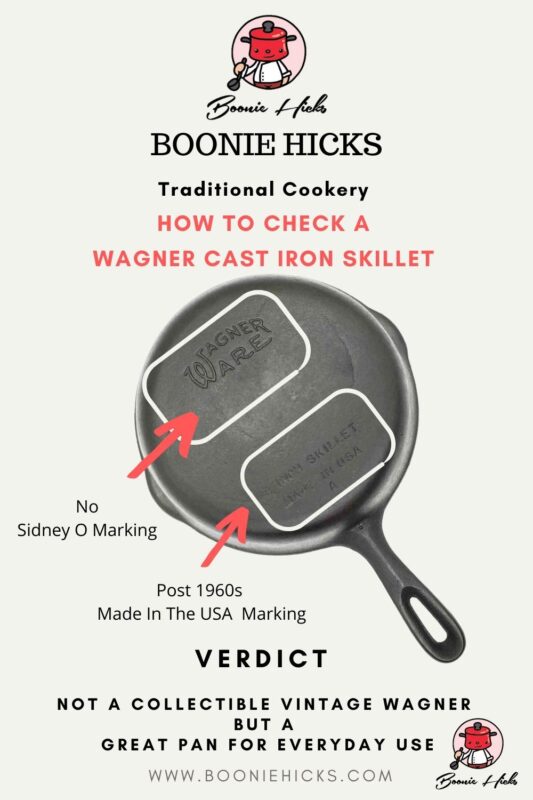
Choose Your Favorite Logo
Wagner changed the logo on their pans several times over the years. Skillets with the stylized logo are popular and well-known. But there are older Wagner skillets with slight logo variations for you to find. Older skillets are less common, making finding them much more fun.
Is One Logo Better Than Another?
I wouldn’t fuss over looking for one logo over another. Sure, you want to watch for the elusive pie logo pans. But I think a lot of people regard the Wagner logos the same.
I also do not strongly prefer the early logos over the stylized Wagner logo, and I think you’ll be happy with any Wagner pan.
So, I’d place more importance on the condition of the skillet and not on the type of logo on the back.
How To Inspect A Wagner Cast Iron Skillet
When you see a Wagner skillet, there are a couple of buying considerations. And I’m sure you can look beyond some of these faults if you see a bargain at a thrift store. But you might want to be choosy if the seller’s asking price is high. After all, plenty of vintage ironware is around, and there’s no need to FOMO in at the first skillet you see.
Should I Buy A Rusty Wagner Pan?
When looking for vintage ironware, I’m unsure if rust is a negative or a positive. Sure, you’d like to find a Wagner skillet in excellent condition. But often, the best bargains can be found when the skillets are a little worse for wear.
I understand you’d prefer one in good shape for your first pan. But removing rust is not hard. And with some time and effort, you can bring the pan back to its former glory. So, I wouldn’t disregard a pan with some surface rust.
Rust Can Hide A Much Larger Problem
I recommend not to hesitate if you see a rusty Wagner skillet at a great price. However, rust can hide hairline cracks. Unfortunately, spotting these cracks until you remove the rust is difficult. Even cast iron restorers that buy and sell cast iron regularly find it difficult to identify potential fractures in the cookware until they start cleaning the iron.
Check The Skillet For Cracks
You can check for cracks if the pan does not have much rust. Check the sides of the pan for fractures in the iron, particularly around the handle where the pan is under more stress.
Unfortunately, hairline cracks may not be noticeable from a glance. So, take your time to inspect the pan. Understandably, the skillet will have little collectability if it has a crack. Cooking with oil may pose a fire risk.
Does Sulfur Pitting Affect Collectability?
Sulfur pitting on the base of the skillet will not affect its usability. It adds character and highlights your cooking with vintage cast iron.
However, sulfur pitting will reduce the desirability of the cookware. So, if you’re considering collecting Wagner Ware, this could be a consideration. Otherwise, I wouldn’t worry about the base. I hesitate to buy the skillet only when the cooking surface has pitting.
Does A Wobble Or Movement In A Wagner Skillet Matter?
When inspecting a Wagner skillet, checking for movement is a good idea. Lay the pan down on a flat surface. With your fingers, press down along the rim of the pan.
If the pan rocks, the base is not entirely flat. It may be unsuitable for flat cooking elements such as glass and ceramic induction.
But if the pan has a tiny amount of movement, I wouldn’t worry about it. However, it is a good idea to check the pan for warp, as Wagner Ware pans can wobble.
Don’t get me wrong, Wagner made excellent cast iron cookware. And it’s a favorite among collectors. And if you’re wondering if Wagner cast iron is any good, you may find this article interesting.
Utensils Marks
Another consideration when buying an antique Wagner skillet is the condition of the cooking surface. Over the years, the cooking surface has likely suffered a few scrapes and scratches. Kitchen utensils and kitchen knives can make visible marks on the cooking surface.
Most of these scratches will fill in over time as the seasoning layer on the skillet builds. However, deeper scratches from kitchen knives may leave nasty visible marks, and the only way to get these out is through gentle restoration.
Pans Without The Sidney O Marking
There are older Wagner cast iron skillets only with the Wagner wording. However, most have the recognizable Wagner Ware Sidney 0 marking. These are the pans that are considered collectible.
However, there are many later pans without the Sidney 0 marking. These skillets are post-1960 and made under different ownership. And I would avoid overpaying for these pans. Consider them skillets for daily use rather than highly collectible ironware.
To learn the Wagner Manufacturing history and logos, check out this articl
Availability Of Wagner Cast Iron Skillets
Another consideration when buying a Wagner skillet is the amount of vintage Wagner cast iron available. Trust me, there isn’t a shortage, and there’s no hurry to purchase.
I recommend taking your time and choosing a skillet that suits your needs. You might want to wait until you find a pan with your favorite Wagner logo or your preferred size.
Conclusion: How To Check A Wagner Cast Iron Skillet
These are a few considerations when buying a vintage Wagner skillet. It’s easy to rush and buy the first frying pan you see. But there isn’t any rush, and you can take your time to research the different skillets available.
Look around this site to learn more about vintage cast iron. Other websites, such as the Cast Iron Collector or Facebook groups, can provide helpful buying advice.
But most importantly, have fun looking and buying your first Wagner skillet. They are exceedingly good pans to use.


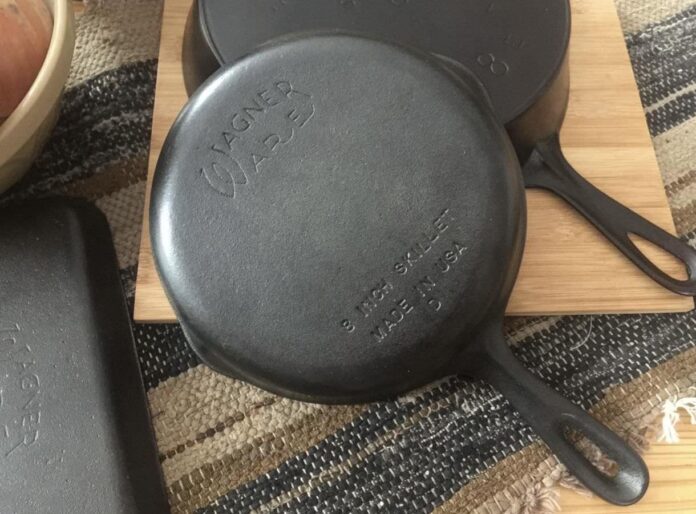
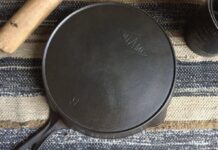
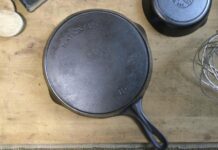
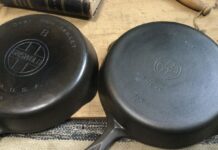



Hello, I bought an old Wagner Ware shallow skillet for cheap. I have asked for help identifying it in a Facebook group but haven’t had any responses except for one member wanting to purchase it.
It’s a shallow skillet with the shared W at the 12 o’clock position and the Sidney “O” under that. 2/3rds down, it has a shallow skillet, then below that is 8A. This one has a heat ring without notches and a handle with three holes. I’m assuming between 1922 and 1935, but I can’t find anything about the three-hole handles. Any insight would be much appreciated.
Thanks for the above article and your help.
Hi Todd
Thanks for getting in touch. I hope the Facebook group gets back to you, as it’s always good to get a second opinion.
A shallow skillet without a four-digit pattern number indicates you have an old pan. Yours has a stylized logo that could be as early as 1915. However, I suspect these skillets were available until the design change in the 1920s.
My estimate is circa 1915-1920s.
Hello!
I found a set of Wagner ware cast irons at a yard sale. The woman said they belonged to her granny, who was about 70 years old.
I believe they are all vintage, as they have the “0”. The largest pan has a different logo. The Wagner is in quotes but has the “0”. It does not have a number on the handle but at the bottom of the backside. The bottom is also not rounded like the others but has a little lip. Is the age before 1960?
Hi Dixie
Sounds like you had a great day at the yard sale. From your description, your larger pan is older than the others. Around the base is a heat ring, indicating the skillet is old. Recheck my Wagner identification guide; I suspect you’ll find a logo matching your pan.
Thanks for getting in touch.
I have a No 8 Wagner cast iron chicken fryer skillet and have been looking for a cast iron lid. I have found one lid for sale. The seller says the lid is Wagner. The lid was made with a hammered top finish. The underside of the lid is marked only with an 8. Did Wagner make that type of lid?
Hi Christon
Thanks for your question.
Wagner did manufacture unmarked hammered ironware. I would definitely do a Google search and compare the hammered finish with your chicken fryer. As the hammered finish varies between manufacturers, also I’d look at the basting ring on the underside of the lid. You want to see basting rings, likely 3 rings with a slight wavy appearance.
Thank you so much for these posts, I’ve found them very helpful.
I’ve been using cast iron most of my life, now I’m 20 and getting into restoration. Last week I found a Wagner pan (8, 10.5 inches, E) at the thrift store for $8. I was really confused when I couldn’t find the pan online anywhere or anything with similar markings. Until now!
It doesn’t have the Sidney O marking on it and it says made in USA. It took about two days to restore because of build up and I had to do it all by hand. But really it was worth the $8!Now I have this beautiful pan that I can still use for life. No questions or anything, just felt like sharing because I’ve been enjoying this as an interest more and more.
Thank you for helping me figure out from when my pan is from! Crazy how a cooking tool can bring so much joy.
Hi Rose,
Thanks for getting in touch and congratulations buying your first vintage pan. It’s a fun hobby and there’s a lot of good people win the community.
Good for you restoring your pan. That takes a lot of confidence. And at 8 dollars, it sounds like you got a great deal. Well done, and have fun using your vintage skillet.
Hi Boonie, thanks for the great info!
I forwarded your link via tweet to someone who found a treasure trove cast iron cook ware. I’m not a collector but I do have an arched Wagoner Ware, with Sidney O underneath. At the bottom it says 1060.
I’m getting ready to re-season, so I really scraped and scoured the entire pan. To my surprise, I discovered the number 10 on the top side of the handle.
Any idea how old this skillet really is? It’s a family heirloom that my son has already called dibs on.
Hi Louanne
It’s great to hear you’ve find the information useful. From the description it sounds like your pan has an early logo. Check the site for the Wagner Ware History, dates and, logos article. This is a guide with examples to identification different Wagner logos. The dates are not perfect but they are close.
Have fun researching.
I have a Dutch oven, with the stamping on the back Wagner’s 1891 Original cast iron cookware. 5 qt. and it has the seasoning instructions. How do I know how old it is and if I have a good pan?
Hi Dora
Thanks for getting in touch.
You have a later piece of ironware to commemorate the 100 year anniversary of Wagner Manufacturing. Your Dutch oven was made by General Housewares Corp in the early 1990s. Unfortunately, they are not considered collectable, but they are great daily users.
Trust this helps
I recently purchased an 1891 11 3/4″ skillet. It has an A mark, which I cannot find one online with the A. Is the “A” rare, or just none available online?
Hi Mike
Thanks for getting in touch.
The A marking on your skillet was used by the foundry to identify the mold used in the production your skillet. It adds to the interest of older skillets, but it does not have any reflection on the collectability or scarcity of the skillet.
It sounds like you have a later piece, probably of the early 1990s.
Hope this helps
I have a griddle grill pan
Marking on the bottom
Wagner Ware Sidney -0-
At the bottom 1108
But it is silver NOT Black as most of cast iron pans.
Any information you would be able to help me with would greatly be appreciated. It was a gift and I was just wondering because I haven’t ever seen one before.
Thank you for your time and help
Hi Kim
Thanks for getting in touch. You comment is no surprise as I’ve seem quite a few 1108 Wagner griddles fitting this description. It sounds like your cast iron griddle was plated. The plating is most likely nickel.
Plated ironware was the forerunner to modern stainless steel cookware, which contains an alloy of iron, chromium, and nickel to prevent rusting.
Hope this helps
Hi.
How do I ‘clean up’ a Wagner Ware pan? (circa 1924-1935). It saw a lot of use before 1985. The year my grandmother died. My mother tried cooking on it, but she was never a good cook nor cleaned the pan up very well.
I recently found it buried in the back of a cabinet and dusted it off. But now what? It sits flat, and it has a heat ring. The cooking surface is smooth.
Help!
Hi Karen
Good on you for bringing your grandmother’s pan back to kitchen duty. The pan could be ready to go if your mum didn’t cook in lard. Give your pan a clean and then a scientific snift test. Your body has a way of saying yes or no.
For the first time, you may want to cook some food scraps like potato peelings to make sure there’s nothing nasty on the surface. But it sounds like it’s has been stored safely. So, if it has no rust or crusty carbon buildup, I’d have a little play. Good times.
To keep your pan flat, I recommend cooking a low heat. These old thin pans can warp easily on high heat. Cook slowly in your vintage pan and have a cheap heavy pan for searing temperatures.
And if your skillet is not in good condition. There is a Youtube channel called cast iron cookware. He has a few videos on restoring vintage cast-iron videos, and he (Steve) knows what he’s doing.
But fun Karen, I’m excited for you.